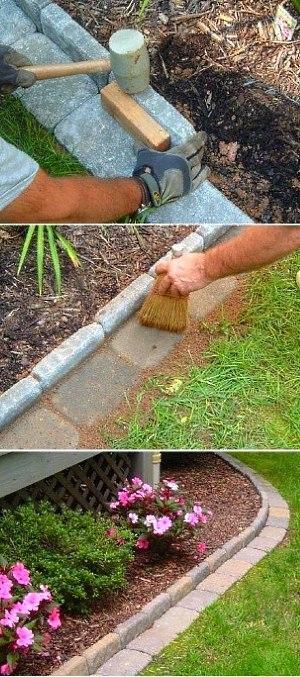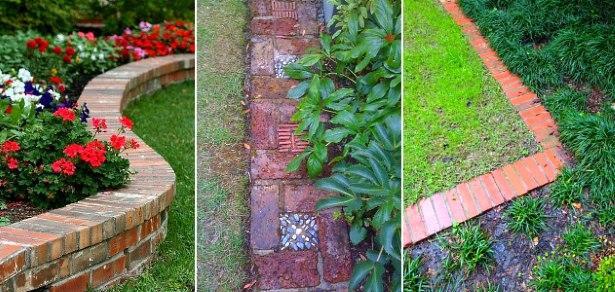How to make a beautiful fence for a flower bed?
 There is an old English expression: "A garden begins with a fence", well, that makes sense. And the same can be fully said about flower beds, the edges of which act as boundaries between plantings and paths, lawns and other elements of the garden landscape: sculptures, fountains, decorative ponds or neighboring flower beds.
There is an old English expression: "A garden begins with a fence", well, that makes sense. And the same can be fully said about flower beds, the edges of which act as boundaries between plantings and paths, lawns and other elements of the garden landscape: sculptures, fountains, decorative ponds or neighboring flower beds.
Fences for flower beds have a complex and important role:
- Bordered flower beds look more neat and well-groomed;
- With the help of fences, you can achieve unity of style throughout the site;
- Decorative fences for flower beds keep plantings from uncontrolled growth;
- They help to divide the territory into zones;
- Protect plantings from accidental damage by pets and people;
- A fenced flower bed is much easier to care for: weed, loosen and water.
And it doesn't matter when the fences for the flower beds are made. Despite the recommendations of the designers, many gardeners think about starting the design of the flower bed with its border. about installing fenceswhen the flower garden is already broken. And this approach, it turns out, is no worse, because the design of the fence will definitely fit the style of the entire garden, and its outlines are already known and time-tested.
The neat design of flower beds affects the perception of the entire space around, and if you make fences for flower beds with your own hands, then the whole garden will turn out to be more stylish and original.
The main thing is to choose an option that suits both style and budget. And there is plenty to choose from. Today, the gardener is given the opportunity to use improvised means, showing his imagination and ingenuity, you can take traditional materials for fences. There are also ready-made, simple and effective solutions.
Brick fences for flower beds
 Classic fences brick
Classic fences brick
By the same principle, fences are made of sidewalk and stone slabs.
Advantages of decorative fences for brick flower beds:
- Made of solid, especially colored bricks, the fencing curbs look very attractive;
- They are strong enough even without concreting;
- Additional soil drainage during heavy rainfall;
- Prevents the growth of plants outside the flower bed.
However, such fences also have disadvantages. Under the influence of moisture and temperature changes, the brick loses its decorative effect and strength. It crumbles and becomes covered with moss and mold, which can also affect crops.

Concrete edging
The concrete edging separating the flower bed from the path or lawn cannot, of course, be called a fence for a flower bed, but today it is more and more often used just such, only visual fences of flower beds, which do not separate it from the audience, but only move it away. Although this decision is a little formal, the border turns out to be extremely strong and irresistible for many types of weeds.
Concrete edging makes mowing easier, while the curved shape can be used to create beautiful garden paths.
Fence for flower beds from wall blocks
Concrete blocks intended for construction can serve as the basis for a durable and highly decorative fence for flower beds. Attach such blocks mono to each other using special glue, and when organizing additional containers for plants in cavities, a metal mesh is taken as the bottom. Drainage is added to each such makeshift container, and then nutrient soil is poured. The height of the block fence must be at least two elements in height.

Fences made of stone
Natural stones of all shapes and sizes can form the basis of original free-form fences, suitable for the design of almost any garden.

Curb tape fencing
Now on sale there are all kinds of special border tape, designed specifically to delimit the line of the path and the flower garden.
It is produced in rolls of various widths and lengths, can be smooth and wavy, one-color and with a pattern. In addition to a tape with a flat top edge, there are also types with a cut-through pattern.
It is extremely easy to mount such a decorative fence for a flower bed. All you need is a tape measure, scissors, a stapler to secure the edges and a shovel.
By analogy with the tape, they also act when installing ready-made plastic fences for a flower bed, imitating a wooden picket fence, bright colors or a log fence.

Along with the undeniable advantages of such a solution, plastic structures have disadvantages:
- The strength of such a fence depends on the quality of the material from which it is made.
- Low-quality plastic quickly loses its quality, becomes dull and brittle, and also, which is quite likely, toxic.
- It is not an obstacle to the spread of weeds.
- Spreading of perennial cultivated plants is not prevented.
- Suitable for annual seasonal plantings.
- Has an unnatural appearance and looks artificial.
Wooden fence for a flower bed
Wood is a traditional material and is in demand at all times. The simplest version of such a fence is a structure of several pegs and a frame knocked down from bars to the size of a flower garden.
A tree is the most environmentally friendly option for a garden fence. This material does not emit toxins and does not harm nature.
There are many options for a wooden fence. These are plank constructions, curbs from processed and left in their natural form logs, vertical and horizontal, high and low.

As a rule, they all harmoniously fit into the design of the garden, but it should be remembered that any wooden structure is susceptible to moisture and pests. Therefore, in order to avoid rotting, the development of lichens and woodworms on the fence, it is important to protect the tree from these hazards before building the fence.

Wattle for a flower bed
This type of fence is very popular and, despite the seeming laboriousness, it is enough to simply weave it from willow twigs or other smooth flexible branches. High wicker fences for flower beds, photos of which are found on the network, are also successfully used for arranging high ridges, strengthening slopes and organizing vertical gardening.

Fences for flower beds and flower beds from slate
 Any household will likely find unnecessary slate trimmings that are often left over from roof repairs. This durable material can make a practical fence for garden beds or flower beds.
Any household will likely find unnecessary slate trimmings that are often left over from roof repairs. This durable material can make a practical fence for garden beds or flower beds.
A narrow, shallow trench is made along the perimeter of the site and strong rods are driven in. The border of the flower bed is laid out with pieces of slate of a suitable size, the trench is covered with earth and compacted.
By analogy with this type of fencing, a structure is made of corrugated board. The material is attached to the blocks protruding from the soil.
Edging with live plants
 A low line of tough plants can make a fantastic decorative fence for your flower bed. Plants should be chosen especially carefully for such a planting: they should lend themselves well to crown formation, provide a dense cover and resist weeds.
A low line of tough plants can make a fantastic decorative fence for your flower bed. Plants should be chosen especially carefully for such a planting: they should lend themselves well to crown formation, provide a dense cover and resist weeds.
Advantages of a living fence for a flower bed:
- It creates a soft and very attractive natural edge;
- Easy to maintain from the moment the hedge is fully strengthened.
Bottle fence
It is a mistake to think that a bottle fence for a flower bed is a kind of economy option.
In landscape design, any materials are not prohibited, if only the composition looks extraordinary and harmonious. Fences can be made from either plastic or more sustainable glass bottles.
So that the vessels do not suffer from changes in humidity and temperature, it is better to fill them in advance with dry sand and close tightly.
Pallet fences
From ordinary wooden pallets, you can make an original fence, both for raised gardens and for cottage gardens, rock gardens and many other structures in an informal style.
The photo of fences for flower beds, made of pallets, shows both a ground version of the structure and a high ridge, raised above the soil level.

Many, even novice gardeners, are quite capable of making an original fence for a flower bed with their own hands. Any material in the hands of a master can become a topic for creativity.
The main thing is not to give up, give free rein to imagination and put a little work into it. And the result will undoubtedly please both the owners of the garden and its guests.
My wife bought Tetto polymer sandy garden fences, installed them on the beds and flower beds, installed conveniently and quickly, looked great, cut the grass with a trimmer, did not get damaged, as they stood and stand, unlike the plastic ones, which were changed every year.